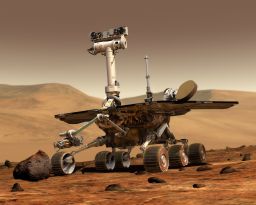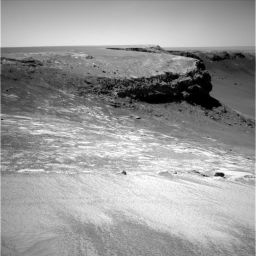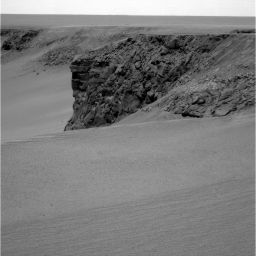A.J.S. Rayl • Sep 29, 2006
Mars Exploration Rovers Update: Spirit Perseveres, Opportunity Arrives at Victoria Crater
The Mars Exploration Rovers are reaching new milestones and gaining newfound energy as winter slowly begins to pass on the Red Planet. Once again, Opportunity commanded the spotlight as it pulled up to the rim of the massive Victoria crater this week and began returning images that may redefine the word spellbinding. Twin sister, Spirit, meanwhile, is resigned to stay in its northward-tilted position for another month looking at the same scenery in order to collect the maximum energy supply for its solar panels.
"We're all pretty focused now on Victoria -- looking at these new NavCam [navigation camera] images and salivating over the PanCam (panorma camera) images, and wondering what we'll see next," said Bruce Banerdt, MER project scientist in an interview with The Planetary Society.
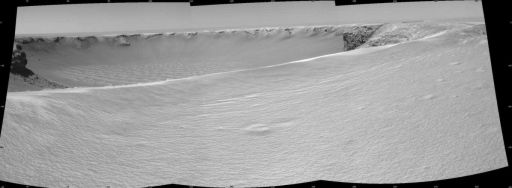 Ohhh -- Victoria
Ohhh -- VictoriaOpportunity reached the rim of Victoria rater in Mars' Meridiani Planum region with a 26-meter (85-foot) drive on Sol 951 (Sept. 26, 2006). "This is a geologist's dream come true," said Steve Squyres of Cornell University, principal investigator for the twin MER rovers. The far wall in this image is approximately 800 meters (one-half mile) from the rover.Credit: NASA / JPL-Caltech / MSSS / OSU
After finishing work on a trench it dug midway across the Victoria Annulus in August, Opportunity essentially spent September on the road to Victoria. The rover did stop briefly at Emma Dean, one in a small cluster of craters on the road to Victoria's rim, but then in short order continued its journey to the grand dame of craters.
Victoria was but a pipedream for Opportunity when the twin robot field geologist landed in January 2004. Within the last couple of days, however, the once impossible dream came true and the rover is currently just a few meters from the rim. It is finally -- after a 21-month journey across the flat plains of Meridiani -- there.
Of course, chuckled Steve Sqyures, the lead rover scientist, of Cornell University, "[a]t the risk of sounding like President Clinton, it depends on what your definition of 'there' is? By which I mean," he continued with a more serious tone, "at what point do you decide you've arrived at the rim? We're not going drive right to the rim on our very attempt and hang 2 wheels over the edge. We're going to get to a safe standoff distance from which we can see enough of the crater to make good decisions," he told The Planetary Society earlier this week. Opportunity has arrived at that safe position.
Measuring some 800 meters (about half a mile) in diameter, Victoria offers the science team untold scientific riches, giving them a glimpse not only into the subsurface, but into Mars' geological history. The initial images from Opportunity's first overlook of Victoria crater show rugged walls with layers of exposed rock and a floor blanketed with dunes. "This is a geologist's dream come true," said Squyres. "Those layers of rock, if we can get to them, will tell us new stories about the environmental conditions long ago. We especially want to learn whether the wet era that we found recorded in the rocks closer to the landing site extended farther back in time. The way to find that out is to go deeper, and Victoria may let us do that."
Spirit, meanwhile, has made some impressive achievements. It spent the month of September at Gusev Crater completing the fill-in images for the McMurdo pan, which is the largest panorama taken on the mission, garnering the rover yet another respectable 'first.'
In addition, it methodically continued its routine analyses of the elemental composition of dust on its magnets and in the atmosphere, and collecting data for the sky and ground surveys that it has been taking all winter from its position at Low Ridge in the Columbia Hills area. By the time the Martian winter is over, this rover will have collected more data about this one spot on Mars than has ever been collected about one locale before, a wealth of data that should better inform both planetary and atmospheric scientists.
The best news for Spirit is that its electrical power increased slightly mid-month, as the Sun began to ascend higher in the sky. With the "superior conjunction" -- a 2-week period when Mars orbits out of sight behind the Sun -- coming up -- the rover will stay in place for at least another month. After conjunction ends on October 29, the rover will finally move, making a clockwise turn to the right to put the instrument deployment device (IDD) within range of some new targets, including a little trench carved by the rover's dragging right front wheel as it pulled in backwards to Low Ridge. While Spirit will be keeping a mellow work profile during the next four weeks or so, focusing on the atmospheric observations that are part of its winter campaign, the action on the other side of the planet, at Meridiani Planum, is certain to keep the rovers in the news.
Overall, Spirit and Opportunity remain healthy. "The rovers are both doing great," reported Squyres. Although each rover has experienced an operational hiccup here and there, overall September proved smooth sailing in terms of their field work. Once again, there has been virtually no change in the performance of either rover's suite of instruments this month, "even the mini-thermal emission spectrometer (mini-TES) on Opportunity, which we've seriously abused," Squyres noted.
One of the big activities for both Spirit and Opportunity in September was booting up with their new flight software, Version R9.2. As it turned out, both rovers successfully woke up in their new software despite some dramatic scrambling by rover handlers to command both MERs to switch to new flight software during a bit of a traffic jam at the Red Planet. The X-band frequency for communicating directly with Earth -- the team's high-speed connection so to speak -- was in use by the Mars Reconnaissance Orbiter which was undergoing critical events for that mission. Engineers seamlessly switched to the back-up plan of using the UHF-band frequency to relay commands indirectly to the rovers via the Mars Odyssey orbiter. Time was of the essence, though, if they were going to begin running and testing the new software before the solar conjunction begins on October 18 making radio communication intermittent at best for a couple of weeks. Everything was going fine. But then -- there was another little wrinkle.
"We were booting the R9.2 software and a network failure occurred here on the ground at JPL, right in the middle of doing all this," said Banerdt. They were able to get the commands up to the spacecraft "through some of relatively heroic work on the part of the ground team here," he said. "We have a back-up command station in another building that's off the main flight network but is connected straight to the Deep Space Network (DSN). Someone finally found a floppy drive that they could use on the machine and walked it across the street to put it on. They regenerated the commands there and sent them up. While they got all the commands up, they couldn't get all the downlinks down. These are all the things that can typically happen, but you hope they don't all happen at once." But in the case, they did.
The MER team lost a couple of days re-doing some of the commanding to make sure the software -- which will give the twins enhanced capabilities -- was working okay. For the most part, the concern was mostly about Opportunity. "Spirit was actually on 2-day sequences, on restricted sols, so it wasn't as affected as Opportunity, which we had planned to command every day," Banerdt explained. "When all this happened, we had to take a day out just to do mobility tests on Opportunity to make sure the R9.2 software worked on Mars the same as we tested it on the ground here."
Since Spirit hasn't moved, it has yet to complete its mobility checks, and most likely won't until it starts to move again. "However, the flight software is identical on both vehicles, so if it works on one it'll work on the other," rationalized Squyres. And, added Banerdt, "[s]o far the software has been working perfectly and we haven't had any unexpected behavior on Mars at all."
In fact, things are going so well with the rovers that the MER team won approval this month for an additional year of funded exploration, a decision NASA made based on recommendations from an outside panel of scientists. [The space agency is also adding two more years of operations for Mars Global Surveyor, which has been orbiting the Red Planet since 1997, and the Mars Odyssey orbiter, in oribt since 2001. The mission extensions officially begin October 1, 2006.]
Spirit from Gusev Crater
At the end of August, Spirit experienced an unexpected software reset during the evening overpass of the Mars Odyssey orbiter on Sol 944 (August 29, 2006) while it was receiving its last command sequences for the month. As a result of the reset, the rover went into automode and did not attempt to execute the master sequence of activities for that day. Apparently, its central processing unit was overworked with several tasks running in parallel at the time.
 Low Ridge Haven
Low Ridge HavenSpirit acquired the images in this mosaic of its winter home with the navigation camera on Sol 807 (April 11, 2006). Approaching from the east are the rover's tracks, including a shallow trench created by the dragging front wheel, whichthe rover will investigate incoming weeks. On the horizon, in the center of the panorama, is McCool Hill.Credit: NASA / JPL-Caltech
As September rolled around, Spirit was back in the saddle, continuing to acquire fill-in images for the McMurdo panorama, and conducting its daily observations of the atmosphere and the sky and ground with the panorama camera (PanCam) and the mini-thermal emission spectrometer (mini-TES).
While the electrical power from the rover's solar array held steady for much of the first half of the month at around 280 watt-hours per sol, the rover kept its 1-hour-a-day work schedule. Like it always has, the rover made the most of it, managing to pack in some work on the soil target, Halley Brunt, with the Mössbauer spectrometer during the first week of the month in addition to its almost daily atmospheric observations and sky and ground surveys with the PanCam and mini-TES.
Despite the tedium of the work, the atmospheric monitoring and sky and ground observations are important endeavors because the Martian atmosphere is much more fickle and complex than Earth's. "The Martian atmosphere is a constantly changing thing -- it changes from day to day and with the season and it changes from year to year. There can be inter-annual differences where one year can be different than the year previous," explained Squyres. "So one of the things we do routinely with both rovers is atmospheric monitoring sequences. The sky and ground observations are standard atmospheric monitoring. We try to run the same sequence each day and we try to run it at roughly the same time of day each day so that we get a nice quantitative baseline that provides a continuous record of atmospheric conditions at both of the rover sites."
One of the main ways Spirit has managed to make such efficient use of its time is by multi-tasking. On Sol 957 (September 11, 2006), the once again demonstrated its enviable capacity by acquiring data on the rock target known as Vostok with the mini-TES while transmitting data to the Odyssey orbiter as it passed overhead. In the days that followed, the rover collected another part of the 15-part image mosaic of its own deck with the PanCam, spent about 5 hours acquiring data on the elemental composition of dust on its filter magnets using the alpha particle X-ray spectrometer (APXS), and took PanCam pictures of the soil target consisting of bright material in the rover’s tracks, known as Tyrone.
As the days passed, the Sun began to rise higher in the sky and Spirit began to experience an upward trend in electrical power, to 287 watt-hours during that second full week in September. The rover increased its workload accordingly, conducting 10 hours of analysis on the elemental composition of dust on its magnets using the APXS, in addition to finishing taking the pictures of its deck for the McMurdo pan, and conducting its daily atmospheric research.
On Sol 960 (September 14, 2006), Spirit mixed things up a bit by taking a morning measurement of sky brightness in the west with the PanCam (known as a PanCam skyspot) and a horizon survey, as well as searching for clouds using the navigation camera (NavCam), and taking pictures of the El Dorado dune field with the PanCam, and the ripples with the rear hazard avoidance camera (HazCam). The rover filled that weekend acquiring data from a target dubbed Macquarie and from from the calibration target with the mini-TES, again searching for clouds with the NavCam, acquiring the last segment of the 15-part panoramic mosaic of its own deck, and conducting a 4-hour and 35-minute APXS analysis of the filter magnets. In addition, Spirit acquired sky images with the PanCam and validated measurements of complete darkness by the camera.
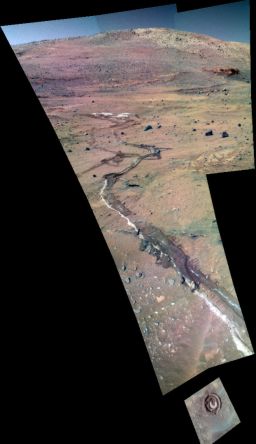 Fragment of Spirit's McMurdo panorama
Fragment of Spirit's McMurdo panoramaSince it's been parked at its winter quarters, Spirit has been working on capturing the largest panorama ever -- a 360-degree view of the surroundings through all 13 filters at very high resolution. This fragment of the McMurdo panorama consists of 16 individual frames captured during Sols 856 to 869 (May 31 to June 11, 2006). Although the view is through the rover's red, green, and blue filters, it is not correctly calibrated, making the sky appear blue and enhancing color variations in the rocks and soils.Credit: NASA / JPL / Cornell / Midnight Mars Browser
Last week, Spirit got off to a roaring start on Sol 963 (September 18, 2006), acquiring images of its tracks with the navigation camera, taking microscopic imager (MI) pictures of the filter and capture magnets, and placing the APXS on the capture magnet. It also took some pictures of its work volume with its HazCam, monitored dust on the PanCam mast assembly, surveyed the horizon with the PanCam, and searched for morning clouds with the navigation camera. But on the following sol, Spirit got an unexpected break.
Rover handlers originally planned to have the rover boot into the new flight software by sending a command over the X-band uplink, but the X-band became suddenly unavailable when it was needed by the Mars Reconnaissance Orbiter (MRO), so Spirit essentially stopped – and then sat, awaiting instructions from Earth. The team sent the reboot command via the UHF-band antenna on the Odyssey orbiter later the same day. And at 11 a.m. local solar time on Sol 965 (September 20, 2006), Spirit woke up for the first time running the new flight software, known as version R9.2.
During the next 2 sols the science activities were light as Spirit ran a series of engineering sequences to establish operating parameters for data products and imaging, and operating parameters for driving and operating the rover's IDD. By Sol 968 (September 23, 2006), Spirit had returned to relatively normal science operations without moving the IDD, as team members awaited confirmation that the rover had established the correct operating parameters for the arm. The rover was able, however, to complete 5 hours of analysis of dust on the rover's capture magnet using the APXS.
Since then, the rover has experienced another power bump. "The power is starting to creep up a little bit at the Spirit site," Squyres confirmed. "The last numbers I saw were a shade above 290 watt hours." [100 watt hours is the energy it takes to power a 100 watt bulb for 1 hour. 500 watt hours is considered good for the rovers, with 850-900 being optimum.]
"The atmospheric dust – which did rise there around the beginning of September -- has gone down a little bit over the last week or two, and it's been dropping since then," expounded Banerdt. "So our energy is finally showing a steady upward trend now."
Spirit has turned its attentions almost entirely to atmospheric studies now, measuring surface reflectivity with the PanCam, measuring atmospheric dust, and completing its morning scans of the sky and ground with the mini-TES, following it with similar observations in the afternoon. The rover is also regularly measuring sky brightness to check for changes over time in the PanCam.
Although the plan has been to have Spirit make a turn to the right once its power rose above 300 watt hours, even if the power rises to an acceptable level in the next week or so, the coming solar conjunction is putting that maneuver on hold. "We're going to turn after conjunction. We don't want to do it before," said Squyres.
Actually, all activities will be pre-commanded and kept to a minimum. The reason is that when Mars goes behind the Sun, the radio signals must then try to pierce through the edge of the Sun to make contact with the spacecraft on the other side. When contact is made, the signal is usually corrupted, so there will be a Command Moratorium in place for the rovers. "We will be attempting downlinks from the spacecraft to Earth pretty regularly, but for safety's sake, we can't depend on being able to use that data," said Banerdt. "Experience shows us we can use a lot of that data. The handlers are very conservative about their link margins in terms of solar activity and the losses through the Sun's corona and things like that, but usually that conservative works in your favor because you get back more than you expect."
Even though Spirit seems to only have "more of the same' in coming days and weeks, its methodical observations of the atmosphere, and surveys of the sky and ground surveys are building a rich bounty of data that will reveal more about this area of Mars than any other single locale characterized by a Martian lander.
Meanwhile, the Spirit team has plenty to keep it busy. The McMurdo pan is complete -- at long last -- and it's a monster of an image. "They finished the last fill-in images so it is complete," confirmed Banerdt. "It hasn't been completely processed, but we've got all the data in hand now to complete the picture."
The main horizon panorama, of course, was released previously, but now the McMurdo pan includes the deck portion of Spirit to the file of thousands of image squares. "We're working on the processing of that now," said Banerdt.
If the McMurdo pan were printed as a life-size picture in its entirety, and you stood in the middle of a 360-degree image, it would seem as if you were standing in Low Ridge yourself. "It's going to take a pretty big piece of paper to put the whole thing on and -- I can't imagine that -- but I'm confident these guys will rev up their memory machines and crank something out soon. I bring the pan up in PhotoShop now and cruise around and look, then choose something to zoom on and then just keep hitting Command plus, Command plus, Comman plus. You can keep going until you're looking at the sand grains. It's amazing."
Opportunity from Meridiani Planum
Opportunity was still tending to its arthritic IDD as August gave way to September, but all indications were that the inadvertent stall at the end of last month was nothing catastrophic, just the same old intermittent annoyance the rover has been experiencing for a while now.
 On the verge of Victoria
On the verge of VictoriaOnce it was more like a distant dream, now it is the ultimate bonus to an already marvelous Martian mission. Opportunity is on the brink of the expansive Victoria crater, a depression that makes those craters it passed on the Meridiani highway look like dimples. At about 800 meters (nearly half-a-mile) in diameter, Victoria is 5 times larger than Endurance crater. Opportunity took this image with its navigation camera. It is labeled to highlight the crater features. Credit: NASA / JPL-Caltech
On Sol 926 (September 1, 2006) the rover took some MI pictures and used the Mössbauer spectrometer on the scuff it dug in the Victoria Annulus, making up for the time it lost when the IDD froze. In the sols that followed, the rover the used the MI to look at targets in the scuff dubbed Powell and Powell's Brother, then used the APXS on Powell's Brother.
Luck has never seemed to stray far from Opportunity since the day it bounced to a landing inside Eagle crater, and it turned up again on Sol 929 (September 4, 2006), after the rover bumped back, took some pictures with the PanCam, then drove forward toward the small crater referred to as Emma Dean. At the end of that drive, the robot field geologist took some post-drive images showing that it had nearly roved for another "hole-in-one," although this one would probably not have been so fortuitous as the one it made on landing in January 2004. Instead, this "almost" was perfect -- the rover drove 100.31 meters (329 feet) to arrive just 5 meters (16 feet) short of the small crater.
During the rest of that first full week in September, Opportunity took several high-resolution images at different angles with its HazCams, then made a short bump to an ejecta rock and spent the remainder of the week conducting untargeted remote sensing of its general surroundings.
Engineers on the ground, meanwhile, worked on determining from images the rover rook on Sol 931 (September 6, 2006), how much "bite" is left in its rock abrasion tool (RAT) or, in other words, estimating how many more grinds it might be able to get with the tool. Spirit's RAT bit ground down long ago and is no longer useable, although it is still able to brush selected targets.
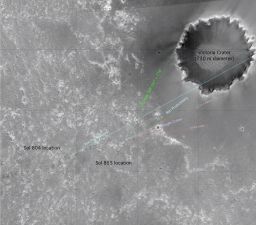 Victoria crater
Victoria craterThis image from the Mars Orbiter Camera (MOC) onboard Mars Global Surveyor clearly shows the "alcoves" of Victoria crater. Opportunity headed up to the rim via Duck Bay, the largest of the "alcoves" which is straight ahead and to the left of Beagle crater.
Credit: NASA / JPL-Caltech / MSSS / OSU
Although Opportunity only drove 1.45 meters (4.8 feet) between Sols 936 and 940 (September 11, 2006 to September 15, 2006), it packed in the atmospheric science during the second week of September. While Americans were remembering 9/11 on the 5th anniversary, Opportunity monitored the amount of dust on itself using the panoramic mast assembly, took daily PanCam taus to assess the clarity of the sky, and in the midst of it all made a short bump to an IDD rock target near Emma Dean called Cape Faraday. The rover then took a PanCam image of the IDD work area, and during the Odyssey pass, multi-tasked with the mini-TES looking at that instrument's calibration target.
In the sols that followed, Opportunity used its mornings for its atmospheric investigations, and then moved on to other tasks, including examining the mini-TES' calibration targets, using its NavCam to search for clouds, and the mini-TES to look at targets dubbed Thompson and Jones. The plan had been to grind into Cape Faraday, but the plan was aborted on Sol 939 (September 14, 2006). "We had another stall in the IDD shoulder motor," explained Banerdt. "We commanded the rover's IDD to move and it seemed to have some hesitation and then the software shut it down as it's designed to do. We went back later and did an exercise and it's just fine. It was like the stall that happened at the end of last month, and there's a hint of something funny going on, but it doesn't seem to be anything seriously at this point," he said. "There are a lot of things that are non-catastrophic that can cause these motors to have little hiccups in them, especially when they gone through thousands of actuations."
"The incident was totally consistent with things we've seen before," added Squyres. "We will see these stalls occasionally and the way we're operating the arm, we actually expect that. There are parameters we can set to try to overcome the bulkiness of the arm. You can set those parameters aggressively or conservatively. If you set them aggressively, faults will be uncommon but you may put the arm at risk. Set them conservatively you keep the arm safe, but faults may be a more common occurrence. We've chosen a fairly conservative set of values that give us good operation of the arm most of the time, and occasionally produces faults [stalls] -- but not so often that it's a big inconvenience and it doesn't put the arm at risk. I think we've found the happy medium. So we do expect to see stalls occasionally and so from time to time we get them, and we just move on."
Cape Faraday, as it turns out, wasn't worth the wear and tear on the RAT anyway. "It was just a very inconveniently placed little piece of outcrop that just wasn't a good RAT target and it turned out to be fairly standard outcrop, nothing special or unusual," said Squyres.
On Sol 940 (September 15, 2005), after finishing its prerequisite atmospheric studies, Opportunity checked out a new rock, named Beaman, with the mini-TES and during the Odyssey pass, the rover use the instrument to look at its own calibration target. During the next couple of sols, Opportunity used the PanCam to image the soil target dubbed Dellinbaugh within Emma Dean, and tested parameters for its IDD with its new flight software.
Opportunity roved into last week with a 35-meter (115-foot) drive on Sol 943 (September 18, 2006). After the drive, the rover paused and took a mid-drive NavCam mosaic of another crater in the series of small craters where Emma Dean lies just outside Victoria, this one named Kitty Clyde's Sister. It then drove another 25 meters (82 feet) and took images with the HazCams, NavCam, and PanCam of its new location, in addition to making more mini-TES observations of the ground.
Sol 944 (September 19, 2006) was "Boot Day" for Opportunity, so that sol and a couple that followed were primarily dedicated to the rover booting into the new Version R9.2 flight software and testing the imaging and data-product parameters to make sure everything was functioning properly. The MER software engineers also devoted a sol to updating the mobility parameters for the new flight software. The rover managed, however, to fill out the week with some additional remote sensing science.
This week, at long last, 21 months of driving, Opportunity began the long-awaited rove up to the rim of Victoria. All told, the rover has driven more than 9.2 kilometers (5.7 miles) since landing and most of that was to get from Endurance crater to Victoria, across the seemingly endless, flat plain, pocked with smaller craters and strewn with sand ripples.
"We are pulling up to the rim of the crater in an alcove we've called Duck Bay," Squyres detailed. "If you look at the shape of this crater it's got these kinds of cut-outs in it -- those are the alcoves and they're separated by points that jut out into the crater and those are the promontories," he explained. "When we pull up to the rim at Duck Bay, there are 2 promontories – one to our right, Cabo Frio, one to left, Cape Verde. Our intention is to pull up to a place along the rim of Duck Bay that's good enough to get a good look at those 2 promontories. Once we've gotten that look, we will choose between the 2 and we will immediately turn back away from the rim and head toward the tip of that promontory. So I don't know how close we're going to get at Duck Bay -- it could be 3 meters or 5 meters or 10 meters back I don't know. But we're going to pull up close enough that we get a good look at CF and CV and pick one of those 2." The jaunt toward the promontory they choose could happen as soon as this weekend, said Squyres.
If you think Victoria crater was named for Queen Victoria, you're not thinking enough like an explorer. "The Victoria was one of Magellan's ships -- the only 1 of Magellan's fleet of 5 ships that completed the full circumnavigation of the globe," explained Squyres. Ferdinand Magellan took an expedition around the world in the 16th-Century. "Magellan left Spain with 5 ships and 260 men," Squyres continued. "And 3 years later, 1 ship, the Victoria, with 18 survivors onboard, made it back to Spain. Victoria crater is named after that ship. This pre-dates Queen Victoria by quite a few years," he points out.
Following that suit, the MER team has chosen to name the main features around the rim -- the promontories and the alcoves -- after places that were visited by the Victoria by Magellan's expedition during it cruise around the world. "Cape Verde, Cabo Frio, and Duck Bay -- Baía dos Patos in Spanish -- were places that were visited by Magellan while he was still in the Atlantic," informed Squyres. Cape Verde is an archipelago off the west coast of Africa (located at 15.02N, 23.34W) comprised of 10 main islands and some 8 islets. "Cabo Frio and Duck Bay are both on the eastern shore of South America," he continued. "Actually, they called it Baía dos Patos because they thought they saw ducks there, but the ducks were actually penguins. Nobody had ever seen penguins before, so they didn't recognize them for what they were. But that's what they were seeing." Little did anyone realize at the beginning of the mission how much rover fans would learn about their own history through the rover jaunts across the Martian landscape.
During the last 2 days, Opportunity has moved closer to the rim and sent back some exciting new images. Late last night, Squyres posted his update on his website (http://athena.cornell.edu/news/mubss/): "The last couple of days have been among the most exciting of the entire mission," he wrote. "The only other events I can compare this to are the two landings and the arrival of Opportunity at Endurance crater."
The order of business now, he reported, is going to be to take "a very big Pancam panorama." That work will begin soon and once it's done, the team has decided to head for -- Cape Verde. That doesn't mean, he wrote, "that we're going to traverse clockwise around the crater... we won't make that decision for quite awhile yet. And it also doesn't mean we'll never go to Cabo Frio."
It does mean that as Opportunity begins its in-depth investigation of Victoria and travels further back in Mars' past than it has gone before, the MER mission will begin anew once again.
Support our core enterprises
Your support powers our mission to explore worlds, find life, and defend Earth. You make all the difference when you make a gift. Give today!
Donate

 Explore Worlds
Explore Worlds Find Life
Find Life Defend Earth
Defend Earth


